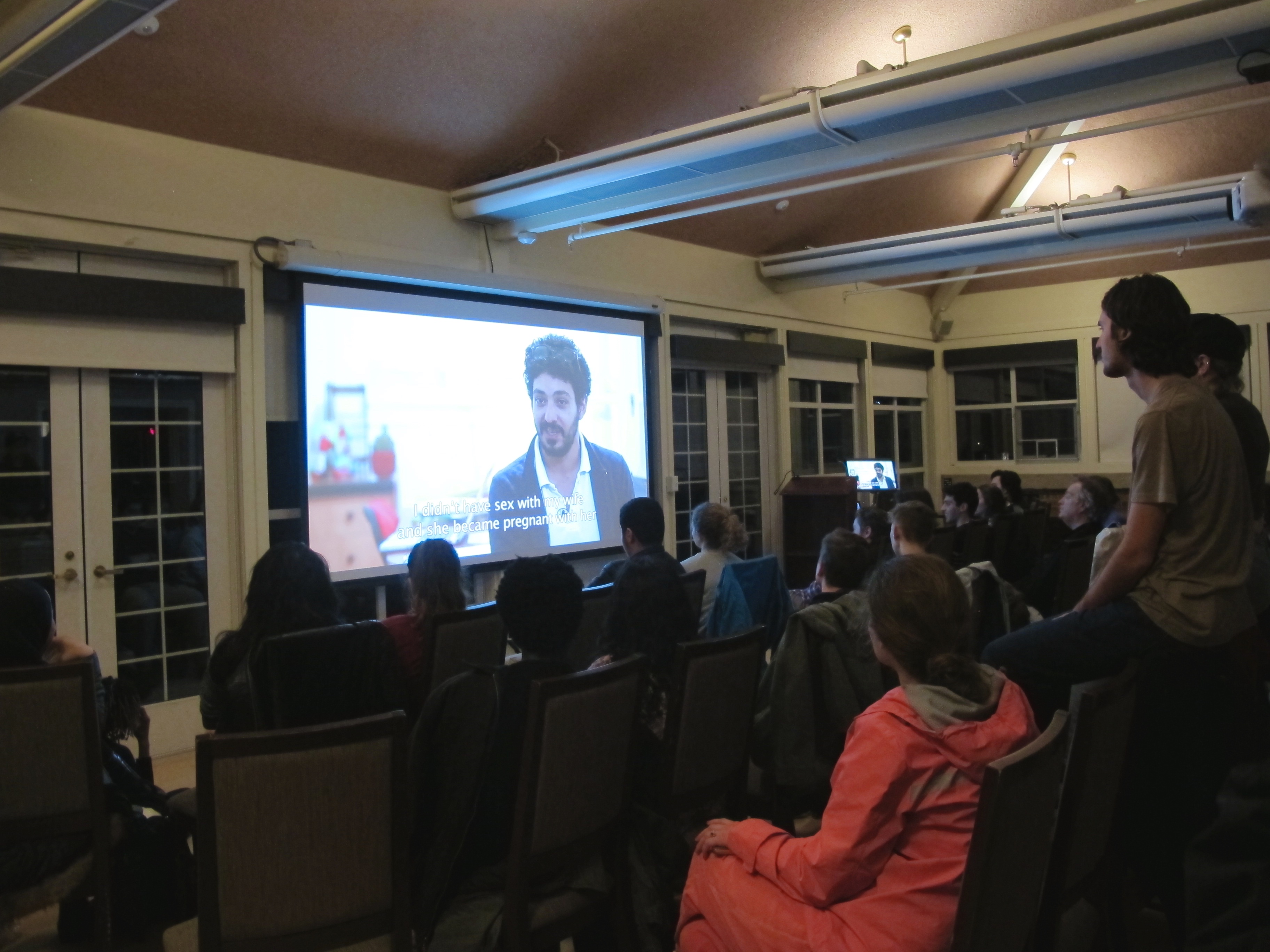
William Halliday, Staff Photographer
On Thursday April 7, the Wesleyan Refugee Project, Wesleyan Students for Justice in Palestine, Students Organize for Syria, and Wesleyan Middle Eastern Perspectives gathered for a screening of “We Cannot Go There Now, My Dear” by decorated Palestinian filmmaker Carol Mansour.
The Syrian-Palestinians that the film follows are refugees twice over. After fleeing their Palestinian homes in 1948, these refugees found succor in Syria’s al-Yarmouk refugee camp.
“We had everything [in Yarmouk],” said refugee and former librarian Fatmeh. “To me it doesn’t feel like the camp. It’s my life.”
Having finally put down roots, Yarmouk’s citizens were reluctant to leave, willing to put up with near-constant bombardment.
“Every day we had between 10 and 15 rocket-propelled grenades falling on the camp,” explained refugee Abu Gaby. “People were saying, ‘we’re willing to put up with the rocket-propelled grenades, we’re willing to put up with the abductions, we’re willing to put up with the clashes’ because they didn’t want to leave their camp.”
As the Syrian civil war and the ensuing crisis deepened, these settled refugees once again faced the threat of displacement. Yarmouk Camp became home to the battle between the Syrian army and rebel forces in 2012. By 2015, it was occupied by ISIS members fighting Hamas-associated forces. Yarmouk’s former inhabitants, who once numbered in the hundreds of thousands, have since scattered.
“We Cannot Go There Now My Dear” is interspersed with grainy cellphone footage of the destruction wrought by the war. In one scene, the streets are filled with people fleeing with the clothes on their back and little else. In the next, the camp is deserted. The violence and damage visible in these shots are striking, but it’s the interviews with refugees—which comprise the body of the film—that serve to drive home a deep sense of loss without belittling the refugees’ agency.
“A lot of movies about refugee crises…tend to be very victimizing,” Wesleyan Refugee Project Co-Founder Casey Smith ’17 said. “There’s definitely a tone that filmmakers tend to strike with refugee films, and I thought this was…much more empathetic and much more about them as people and their careers and their lives and not just about them being victims in some sort of white savior complex film.”
Wesleyan Middle Eastern Perspectives Co-Founder Rajaa Elidrissi ’16 also stressed the importance of using the voices of the people caught up in conflict as primary sources for studying these events.
“People should look to sources like this for [information] about the Middle East and struggles about narratives from people in Israel and Palestine instead of focusing only on history books,” Elidrissi said.
Within the film, the refugees and the narrative poetry woven throughout their interviews tell the tale of lives filled with loss and fear.
“We have inherited destitution,” said Abu Gaby, who lost over 20 loved ones in the war.
Rawan, another refugee featured in the film, elaborated on the lasting effects of these traumas.
“The most difficult thing is to live an unsettled life,” Rawan said. “You don’t know [what’s going to happen]; you’re living day-by-day. We have nothing to look forward to.”
The psychological toll of this ongoing displacement resonated deeply with the audience.
“[They] have to settle to survive, and then the second time they’re like ‘Is it going to happen again?’ Do we even have to settle? Can we settle?” said Thafir Elzofri ’19. “I also have family who are refugees; they’re from Yemen…. Obviously it’s not the exact same situation. Because they’re close to me it seems bad but to actually see it even worse—I didn’t think [it] was possible.”
Questions of adaptation and coping run through the film.
“At first it used to be that if you were away from someone you love, you’d feel anxiety,” said refugee Nisreen Shunna. “Now, maybe because there’s so much pain, you deal with it as if it’s normal. There were many things that used to affect you, now you feel that they are normal.”
The double displacement these refugees face comes with complex emotional and legal issues. The refugees are haunted by a yearning to return, both to Syria and Palestine. Since Palestine is not recognized as a state, Palestinian refugees lack legal refugee status, and thus face difficulties accessing aid and acquiring legal travel documents.
“Palestinians from Syria are often seen as a kind of invisible minority who are often subject to all these other obstacles related to being stateless and lacking a lot of rights in Lebanon and other countries in the Arab world, so it’s an important story to get out there,” said Students for Justice in Palestine member Harry Russell ’16.
Smith agreed, emphasizing the complex nature of the conflict.
“I hope that people take away the intersectionality of the issues of Israel-Palestine and the issue of Syrian refugees because those are two very salient issues right now,” Smith said. “We don’t necessarily think of them as intertwined, but they really are.”
Comments are closed